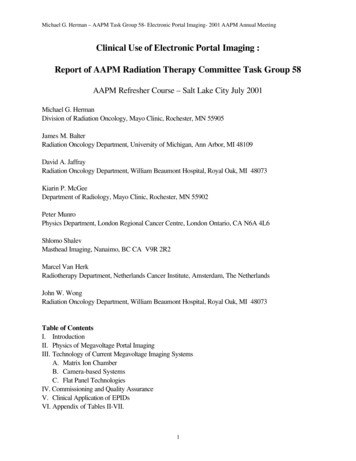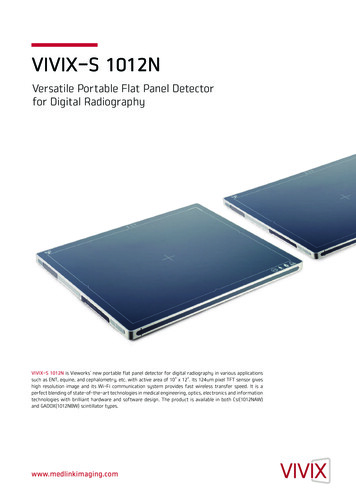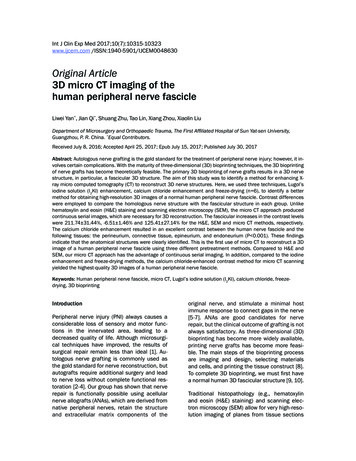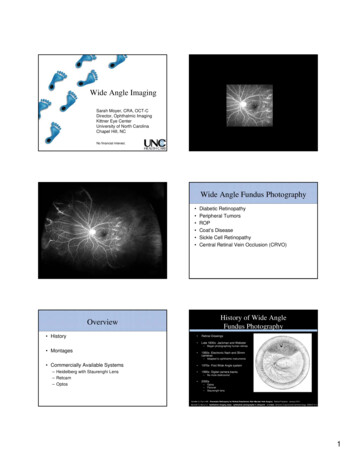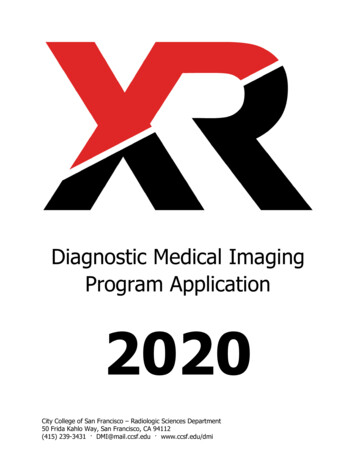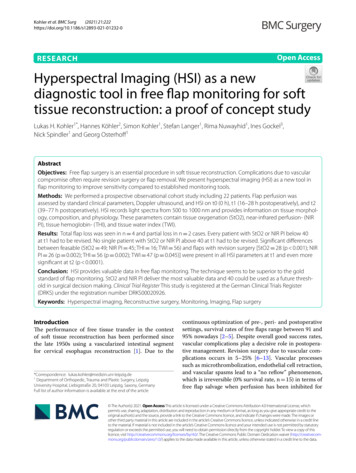
Transcription
(2021) 21:222Kohler et al. BMC Surghttps://doi.org/10.1186/s12893-021-01232-0Open AccessRESEARCHHyperspectral Imaging (HSI) as a newdiagnostic tool in free flap monitoring for softtissue reconstruction: a proof of concept studyLukas H. Kohler1*, Hannes Köhler2, Simon Kohler1, Stefan Langer1, Rima Nuwayhid1, Ines Gockel3,Nick Spindler1 and Georg Osterhoff1AbstractObjectives: Free flap surgery is an essential procedure in soft tissue reconstruction. Complications due to vascularcompromise often require revision surgery or flap removal. We present hyperspectral imaging (HSI) as a new tool inflap monitoring to improve sensitivity compared to established monitoring tools.Methods: We performed a prospective observational cohort study including 22 patients. Flap perfusion wasassessed by standard clinical parameters, Doppler ultrasound, and HSI on t0 (0 h), t1 (16–28 h postoperatively), and t2(39–77 h postoperatively). HSI records light spectra from 500 to 1000 nm and provides information on tissue morphology, composition, and physiology. These parameters contain tissue oxygenation (StO2), near-infrared perfusion- (NIRPI), tissue hemoglobin- (THI), and tissue water index (TWI).Results: Total flap loss was seen in n 4 and partial loss in n 2 cases. Every patient with StO2 or NIR PI below 40at t1 had to be revised. No single patient with StO2 or NIR PI above 40 at t1 had to be revised. Significant differencesbetween feasable (StO2 49; NIR PI 45; THI 16; TWI 56) and flaps with revision surgery [StO2 28 (p 0.001); NIRPI 26 (p 0.002); THI 56 (p 0.002); TWI 47 (p 0.045)] were present in all HSI parameters at t1 and even moresignificant at t2 (p 0.0001).Conclusion: HSI provides valuable data in free flap monitoring. The technique seems to be superior to the goldstandard of flap monitoring. StO2 and NIR PI deliver the most valuable data and 40 could be used as a future threshold in surgical decision making. Clinical Trial Register This study is registered at the German Clinical Trials Register(DRKS) under the registration number DRKS00020926.Keywords: Hyperspectral imaging, Reconstructive surgery, Monitoring, Imaging, Flap surgeryIntroductionThe performance of free tissue transfer in the contextof soft tissue reconstruction has been performed sincethe late 1950s using a vascularized intestinal segmentfor cervical esophagus reconstruction [1]. Due to the*Correspondence: lukas.kohler@medizin.uni-leipzig.de1Department of Orthopedic, Trauma and Plastic Surgery, LeipzigUniversity Hospital, Liebigstraße 20, 04103 Leipzig, Saxony, GermanyFull list of author information is available at the end of the articlecontinuous optimization of pre-, peri- and postoperativesettings, survival rates of free flaps range between 91 and95% nowadays [2–5]. Despite overall good success rates,vascular complications play a decisive role in postoperative management. Revision surgery due to vascular complications occurs in 5–25% [6–13]. Vascular processessuch as microthrombolization, endothelial cell retraction,and vascular spasms lead to a “no reflow” phenomenon,which is irreversible (0% survival rate, n 15) in terms offree flap salvage when perfusion has been inhibited for The Author(s) 2021. Open Access This article is licensed under a Creative Commons Attribution 4.0 International License, whichpermits use, sharing, adaptation, distribution and reproduction in any medium or format, as long as you give appropriate credit to theoriginal author(s) and the source, provide a link to the Creative Commons licence, and indicate if changes were made. The images orother third party material in this article are included in the article’s Creative Commons licence, unless indicated otherwise in a credit lineto the material. If material is not included in the article’s Creative Commons licence and your intended use is not permitted by statutoryregulation or exceeds the permitted use, you will need to obtain permission directly from the copyright holder. To view a copy of thislicence, visit http://creativecommons.org/licenses/by/4.0/. The Creative Commons Public Domain Dedication waiver ) applies to the data made available in this article, unless otherwise stated in a credit line to the data.
Kohler et al. BMC Surg(2021) 21:222Page 2 of 9more than 12 h in a rabbit model after revascularization.Flap salvage in the correlated groups with revascularization after 1 h (n 15), 4 h (n 15) and 8 h (n 15) was80–100%. Thus the survival rate is inversely related to theoccurrence of ischemia [14, 15].Vascular monitoring of the transplanted flaps by clinical and instrumental tools is therefore of crucial importance and leads to a better outcome [16]. Monitoringshould be rapid, accurate, reliable, and practicable to allflap types. The gold standard of flap monitoring to dateis clinical assessment (flap color, capillary refill, tissueturgor, temperature) and handheld Doppler sonography[17]. Several other techniques measure the circulatoryflow (implantable Doppler, color duplex ultrasonography, fluorescence angiography, laser Doppler flowmetry)or tissue metabolism and ischemia (Near-Infrared Spectroscopy, microdialysis) [18–23]. So far, however, none ofthese methods have been able to establish itself in clinical routine since there is a lack of data that demonstratesa reliable, clinical superiority and cost efficiency [17, 18,24].A particular challenge is the monitoring of transplanted flaps without a skin island. The skin is missingas a reliable predictor of possible vascular complications.In the case of venous thrombosis, for example, Dopplerultrasound continues giving regular sound feedback andabnormal tissue configuration can be prolonged [25, 26].Hyperspectral imaging is a new in vivo imaging technique that combines the principles of spectroscopy andimaging in a non-contact fashion to provide informationabout tissue morphology, composition, and physiology[27]. HSI creates high-resolution images that contributeinformation about oxygenation or ischemia in superficial tissue layers. Several experimental and clinical studies have shown that HSI delivers reliable data in wounds(diabetic, peripheral arterial occlusive disease, burn) [28–33], oncologic surgery (esophagectomy) [34], intestinalresections [35], left liver resection [36] and maxillofacialsurgery [37].This study aims to show the superiority of the HSItechnique over already established monitoring procedures and that it can thus reduce the occurrence of vascular complications.Patients and methodsStudy collectiveWe performed a prospective observational cohort study.Patients aged 18 and older who underwent soft tissuereconstruction using a free flap between March 2019 andJanuary 2020 and had given informed consent were eligible. In total, 22 patients (17 males, five females) with amedian age of 55 (26–92) were included. Next to age, weanalyzed gender, flap indication, comorbidities, and thehospitalization after surgery (Table 1).Flaps included ALT flaps (n 11), Latissimus Dorsiflaps (n 4), Deep Inferior Epigastric Artery Perforator(DIEAP) flaps (n 3), Muscle Sparing Free TransverseRectus Abdominis Myocutaneus (MS2-TRAM) flapsTable 1 Baseline dataNo revisionPartial revisionComplete revisionN (22)1624Age [year]52.5 (SD 14)65.5 (SD 37)57.5 (SD 12)Gender er300POVDHospitalization after surgery (d)00112 (SD 6.6)11.5 (SD 2.1)30 (SD 14.5; p 0.0013)Comorbidities [n (%)]Diabetes2 (12.5%)03 (75%)POVD2 (12.5%)1 (50%)1 (25%)CHD2 (12.5%)01 (25%)Arterial hypertonia6 (37.5%)03 (75%)Atrial fibrillation001 (25%)Smoking3 (18.8%)01 (25%)Cancer history3 (18.8%)00Oral anticoagulation1 (6.3%)01 (25%)*POVD peripheral occlusive vessel disease, CHD chronic heart disease
Kohler et al. BMC Surg(2021) 21:222Page 3 of 9(n 2), Parascapular flaps (n 1) and Rectus Abdominisflaps (n 1). Both flaps with (n 18) and without (n 4)skin islands were included.The primary endpoint was revision surgery during hospitalization and the primary outcome was the revisionrate.Flap assessment by clinical and handheld DopplersonographyFlap perfusion was assessed by standard clinical parameters (flap color, capillary refill, tissue turgor, temperature)regularly due to our clinical standard assessment (every2 h within the first 24 h and every 4–72 h postoperatively) by handheld Doppler ultrasound (Dopplex D900Audio Only Doppler, Huntleigh Healthcare Limited, Cardiff, United Kingdom).Flap assessment by hyperspectral imagingNext to clinical and Doppler controls, we performedhyperspectral imaging at three fixed points in time(t0 day of surgery, t1 first day postoperatively,t2 second day postoperatively) using the hyperspectral imaging camera and its evaluation software (Fig. 1).For HSI data acquisition the commercially available TIVITA Tissue camera (Diaspective Vision GmbH,Germany) was used. The system uses a built-in halogenlight source to record reflectance spectra from 500 to1000 nm in 6.4 s. This data is processed in real-time andfalse-color images represent physiologic tissue parameters in the range from 0 to 100. These parameters werepreviously described and evaluated by Holmer et al.[38]. Tissue oxygenation (StO2) and near-infrared perfusion index (NIR PI) are more suitable for the assessment of flap perfusion than tissue hemoglobin- (THI)and tissue water index (TWI). Thus, the focus in thiswork is on StO2 and NIR PI. StO2 provides information about the microcirculation in the most superficialtissue layers (penetration depth 1 mm) whereas nearinfrared light has a higher penetration depth (4–6 mm)into the body due to lower absorption by hemoglobin.The field of view (FOV) for all parameters was 21 30 cm2, which corresponds to the size of a DIN A4 page,and the spatial resolution was 0.56 mm at 630 nm(evaluated with the 1951 USAF resolution test chart at50 cm object distance). For the measurement process,the hyperspectral camera, which consists of a mobiletable stand, a swiveling hyperspectral camera including illumination unit and objective lenses as well asintegrated evaluation software, is placed at a distanceof 50 cm above the patient in a contactless fashion. Thedata recorded by the camera is visually processed by thebuilt-in software supplied and made available as falsecolor images. The entire evaluation takes about 15 s, isFig. 1 The Hyperspectral Imaging Camera System consisting ofa mobile table stand, a swiveling hyperspectral camera includingan illumination unit and objective lenses as well as the integratedevaluation software. Picture Copyright Leipzig University Hospital,Department of Orthopedic, Trauma and Plastic Surgery; LeipzigSaxony, Germanycontactless and safe. Further analysis was performedby placing three circular regions of interest (ROI) atthe center of the proximal third, intermediate, and distal flap part with diameters about 3 cm. Each ROI wasassessed separately regarding the clinical parameters,mean StO2, and mean NIR PI.Statistical analysisContinuous data are presented in mean and standarddeviation (SD), categorical data in frequencies and percentages. The f-test was performed to check for equalvariances and an unpaired two-tailed Student’s t-test wasused to detect differences in means of normally distributed data. P-values less than 0.05 were considered significant. All calculations were performed with T IVITA Suite and Microsoft Excel 2013. For flap survival, a complete or partial revision was counted as an event. Theobservation period ended after the patient dischargefrom the hospital.Institutional review board numberThe study protocol of this study was approved by theinstitutional ethics committee (reference number051/19-ek).
Kohler et al. BMC Surg(2021) 21:222ResultsBaseline dataComplete revision of the flap was necessary in four cases(18.2%) including two Latissimus Dorsi flaps, one Rectus abdominis flap, and ALT flap. Partial revision in twocases (9.1%), both were ALT flaps. The indication forrevision was determined by our routine check-ups (clinical, handheld Doppler). Revision surgery in cases withcomplete flap loss was performed between postoperative day two and eight. One case with partial flap loss wascovered with split skin 20 days after initial surgery, theother case was managed in a secondary wound healingsetting without the need for revision surgery. None of therevised flaps could be saved by an early salvage revision.Three of the six revised flaps were skin island flapdesigns (50%). Patients with complete flap removal hadsignificantly longer hospitalization (p 0.0013). Theother baseline data parameter age, gender, flap indication, and comorbidity did not present any significant differences in correlation to flap survival (Table 1).Hyperspectral imagingSixteen out of 22 flaps showed regular healing with noneed for revision surgery (72.2%). In all these 16 viableflaps, both StO2 (p 0.0002) and NIR PI (p 0.0022)were above 40 at t1. Furthermore, all flaps that had StO2and NIR PI values below 40 at t1 had to be partially orcompletely revised due to partial or complete flap loss(Fig. 2). These differences between viable (StO2 49;Page 4 of 9NIR PI 45; THI 16; TWI 56) and revised flaps[StO2 28 (p 0.001); NIR PI 26 (p 0.002); THI 56(p 0.002); TWI 47 (p 0.045)] were present in all tissue parameters at t1 and even more significant (p 0.0001for all tissue parameters) at t2 (Figs. 3, 4). All cases withcomplete flap loss showed venous thrombolization.The cause of partial flap loss could not be conclusivelydetermined. It is suspected that critical perfusion wasachieved in the tissue areas furthest away from the anastomosis (Fig. 5a–c).The HSI technique was able to provide valid data forflaps with and without skin islands as well as split skingrafted free flaps (Fig. 5d–f ).Clinical assessment and Doppler ultrasound were notable to detect flap failure at t0 or t1 in any of the revision cases. At t2, two out of 6 (25%) revised flaps showedclinical anomalies, both skin paddle free flaps. None ofthe three revised flaps without skin island showed clinicalanomalies nor irregular Doppler ultrasound at t0–t2.DiscussionThe monitoring of flaps in reconstructive surgery hasbeen a much-described topic since the 1970s and is stillof great interest. So far, none of the many invasive andnon-invasive monitoring tools has managed to clearlydistinguish itself from clinical evaluation only. Our findings indicate that hyperspectral imaging technologymight close this gap, delivering reliable data in a patientand user-friendly setting.Fig. 2 Tissue oxygenation (StO2-) and NIR Perfusion Index of all measured areas at t1 (three areas per flap). The orange square is indicating thecritical zone. All areas on viable flaps were outside and at least one area of each revised flap was in the critical zone
Kohler et al. BMC Surg(2021) 21:222Page 5 of 9Fig. 3 Tissue oxygenation (StO2-) Index differences over time (t0-t2) between revised (n 6) and non-revised flaps (n 16)Fig. 4 NIR Perfusion Index differences over time (t0–t2) between revised (n 6) and non-revised flaps (n 16)In this pilot study with 22 patients, HSI was observedto demonstrate superiority to clinical and Doppler ultrasound monitoring assessments. The technique was notonly accurate; it was also faster in detecting signs of vascular problems. This may help to prevent flap losses dueto reasons that could be missed clinically. Chen et al.demonstrated, that the timing of occurrence of first vascular compromise signs is of the greatest importanceand dictates the outcome of free flap salvage surgery [37,39]. HSI managed to detect decreasing perfusion of the
Kohler et al. BMC Surg(2021) 21:222Page 6 of 9Fig. 5 First line (a–c) showing a patients HSI results on t1 showing decreasing circulatory support with increasing distance from the A. tibialisanterior pedicle. The distal part had to be revised and covered by meshed skin graft. Second line (d–f) showing HSI results in a Latissimus Dorsi freeflap tissue transfer on t0 indicating complete flap failure (both in StO2 and NIR PI)transferred tissue latest 16–28 h postoperatively. Clinicalassessment and Doppler ultrasound failed to detect anyof those revised cases on day 1 after surgery (Fig. 6). TheDoppler ultrasound showed regular findings during theentire observation period, as the monitoring is limitedto arterial feedback. Arterial thrombosis is significantlyless frequent in free tissue transfer [25, 40], which alsoemphasizes the advantages of HSI technology in detecting venous and arterial vascular compromises. Not onlydoes it indicate a vascular problem, but it is also able todistinguish venous from arterial compromise by patterndifferentiation as Holmer et al. have already described[38].For future decision making, the value 40 (NIR PI 40;StO2 40%) seems to play a decisive role here and couldbe investigated as a future threshold in reconstructivesurgery. So far, no cut-off values have been defined forthe individual HSI parameters, but studies are outliningtissue oxygenation of 50 and higher as an indicator forregular wound healing, 30–50 as a grey zone, and lowerthan 30 as a predictor of bad wound healing caused bylack of perfusion [41].Perfusion related indices have already proven to bea good indicator for vascular compromise not only inwounds [28–32] but also in reconstructive surgery. Repezet al. [42] monitored 50 flaps continuously with nearinfrared spectroscopy (NIRS) and compared it to clinicalobservation alone. NIRS detected all cases of flow failure before clinical observation with no false positives ornegatives. These results are consistent with our findings.
Kohler et al. BMC Surg(2021) 21:222Page 7 of 9Fig. 6 First column (a, d, g) HSI color image; second column (b, e, h) HSI StO2; third column (c, f, i) HSI NIR Perfusion Index. First line (a–c) t0, second row (d–f) t1, third line (g–i) t2. HSI photos and parameters over time. It becomes apparent that critical zones are already visible inthe HSI, even though the clinical appearance is still regular (d–f). The critically areas both had to be removed and covered by meshed skin graftAll revised flaps could be detected earlier by HSI, especially by parameters measuring the oxygen saturation inthe superficial tissue layers (StO2 up to 1 mm; NIR PI upto 4–6 mm) [38].The limitations of this study include its small samplesize and the heterogeneity of the study’s endpoint. Also,to improve selectivity in future studies with higher casenumbers, it may be of interest to split individual flap
Kohler et al. BMC Surg(2021) 21:222entities by composition (fasciocutaneous, myocutaneous) and by the entity (e.g., ALT, latissimus dorsi, subscapular). However, we want to outline that HSI is ableto analyze different tissues like skin or just muscle and isthus able to deliver reliable data for different flap designs.A cost-efficiency analysis has to be planned to not onlyshow clinical evidence, but also practicability in the longterm. The current technology allows only static images.It should be discussed whether the technique is not alsocapable of producing dynamic images and thus providing continuous information about perfusion conditions.Future studies may then monitor flaps continuously sothat early detection of vascular compromise can allow forimmediate return to the operating room. Furthermore,HSI data could help intraoperatively to analyze the perfusion of the flap after performing the anastomosis andthus help surgeons in case of early, intraoperative decision making.Nevertheless, HSI is an approach with high potentialand could lead to lower total flap failure and higher salvage rates leading to better overall survival. It combinesthe advantages of non-invasive and invasive monitoringmethods and has so far only shown advantages comparedto the other techniques.ConclusionHyperspec
Vascular monitoring of the transplanted aps by clini-cal and instrumental tools is therefore of crucial impor-tance and leads to a better outcome [16]. Monitoring should be rapid, accurate, reliable, and practicable to all flap types. e gold standard of ap monitoring to date
